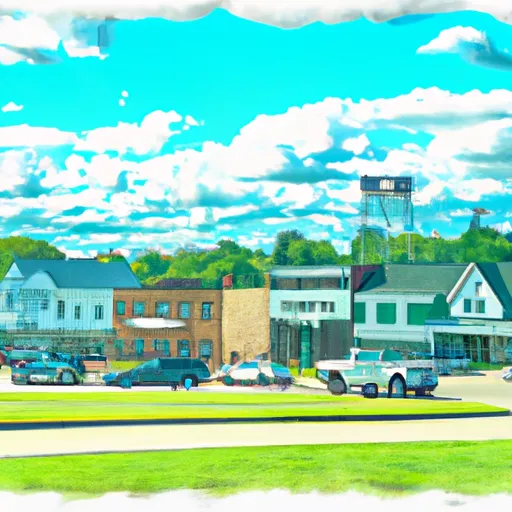-
 Snoflo Premium
Snoflo Premium
Get unlimited access to all our content
With no Ad interruptions! - Start Your Free Trial Login with existing account
Kearsarge
Eden Index
Climate
5.8
•
Recreation
5.5
•
Community
1.9
•
Safeguard
4.7/10

Kearsarge is a small unincorporated community located in the Upper Peninsula of Michigan. Situated in Houghton County, it is known for its scenic beauty and abundant outdoor recreational opportunities.
Kearsarge experiences a humid continental climate, characterized by cold and snowy winters, and mild summers. Average temperatures range from around 10°F (-12°C) in January to 67°F (19°C) in July. The area receives ample precipitation throughout the year, with snowfall being particularly significant during the winter months.
Hydrologically, Kearsarge benefits from its proximity to Lake Superior, the largest of the Great Lakes. The lake's influence helps moderate temperatures and can contribute to lake-effect snowfall. Additionally, the region is dotted with numerous rivers, streams, and waterfalls, providing opportunities for fishing, kayaking, and other water-based activities.
Outdoor recreation enthusiasts will find plenty to explore in and around Kearsarge. The nearby Porcupine Mountains State Park offers hiking trails, camping sites, and opportunities for wildlife viewing. Snowmobile and cross-country skiing trails are abundant in the winter, allowing visitors to enjoy the snowy landscapes. The area is also a popular spot for hunting, biking, and birdwatching. In summary, Kearsarge provides a picturesque setting for a variety of outdoor activities, making it an attractive destination for nature lovers.
What is the Eden Index?
The Snoflo Eden Index serves as a comprehensive rating system for regions, evaluating their desirability through a holistic assessment of climate health, outdoor recreation opportunities, and natural disaster risk, acknowledging the profound impact of these factors on livability and well-being.
Climate Health Indicator (CHI): 5.8
Kearsarge receives approximately
837mm of rain per year,
with humidity levels near 82%
and air temperatures averaging around
5°C.
Kearsarge has a plant hardyness factor of
5, meaning
plants and agriculture in this region thrive during a short period during spring and early summer. Most
plants will die off during the colder winter months.
By considering the ideal temperature range, reliable water supplies, clean air, and stable seasonal rain or snowpacks, the Climate Health Indicator (CHI) underscores the significance of a healthy climate as the foundation for quality living.
A healthy climate is paramount for ensuring a high quality of life and livability in a region, fostering both physical well-being and environmental harmony. This can be characterized by ideal temperatures, reliable access to water supplies, clean air, and consistent seasonal rain or snowpacks.
Weather Forecast
Streamflow Conditions
Southcentral Lake Superior
Area Rivers
Southcentral Lake Superior
Snowpack Depths
Southcentral Lake Superior
Reservoir Storage Capacity
Southcentral Lake Superior
Groundwater Levels
Recreational Opportunity Index (ROI): 5.5
The Recreational Opportunity Index (ROI) recognizes the value of outdoor recreational options, such as parks, hiking trails, camping sites, and fishing spots, while acknowledging that climate plays a pivotal role in ensuring the comfort and consistency of these experiences.
Access to outdoor recreational opportunities, encompassing activities such as parks, hiking, camping, and fishing, is crucial for overall well-being, and the climate plays a pivotal role in enabling and enhancing these experiences, ensuring that individuals can engage in nature-based activities comfortably and consistently.
Camping Areas
| Campground | Campsites | Reservations | Toilets | Showers | Elevation |
|---|---|---|---|---|---|
| Desplaines Conservational Park | None | 553 ft | |||
| Village Park | 26 | 603 ft | |||
| Jurgens City Park | None | 658 ft | |||
| Des Plaines State Conservation Area | 22 | 516 ft | |||
| Gratiot River County Park | None | 626 ft | |||
| Baraga State Park | None | 612 ft | |||
| South City (Gibson) Park | None | 741 ft | |||
| McLain State Park | 100 | 625 ft | |||
| Lanse Township Park | 30 | 696 ft | |||
| Gibson City Park | 4 | 731 ft |
Catastrophe Safeguard Index (CSI):
The Catastrophe Safeguard Index (CSI) recognizes that natural disaster risk, encompassing floods, fires, hurricanes, and tornadoes, can drastically affect safety and the overall appeal of an area.
The level of natural disaster risk in a region significantly affects safety and the overall livability, with climate change amplifying these risks by potentially increasing the frequency and intensity of events like floods, fires, hurricanes, and tornadoes, thereby posing substantial challenges to community resilience and well-being.
Community Resilience Indicator (CRI): 1.9
The Community Resilience Indicator (CRI) recognizes that education, healthcare, and socioeconomics are crucial to the well-being of a region. The CRI acknowledges the profound impact of these elements on residents' overall quality of life. By evaluating educational resources, healthcare accessibility, and economic inclusivity, the index captures the essential aspects that contribute to a thriving community, fostering resident satisfaction, equity, and social cohesion.

